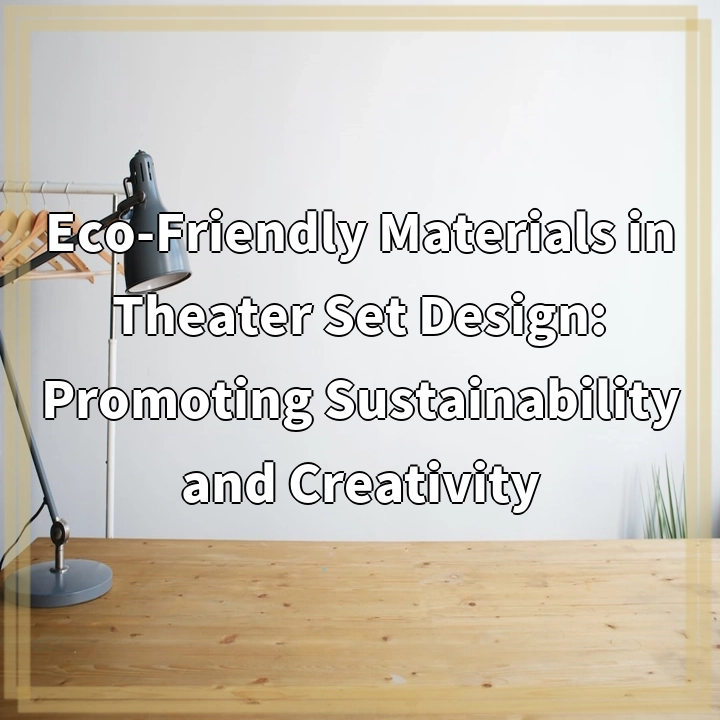
What it is:
The use of eco-friendly materials in theater set design refers to the incorporation of sustainable and environmentally-conscious materials in the construction and decoration of stage sets. These materials are chosen to minimize negative environmental impacts, reduce waste, and promote a more sustainable and responsible approach to theater production.
By using eco-friendly materials, theater practitioners aim to create sets that not only captivate audiences but also align with ethical and environmental considerations. This involves using recycled or repurposed materials, opting for renewable resources, embracing non-toxic and low-emission alternatives, and practicing responsible waste management throughout the production process.
Real-World Problems:
Despite the growing awareness and efforts to promote sustainability in theater production, there are several challenges and problems associated with using eco-friendly materials in theater set design.
1. Limited Availability: One of the main challenges is the limited availability of eco-friendly materials specifically tailored for theater set design. While more sustainable alternatives are becoming available in other industries, finding suitable options for creating realistic and visually appealing sets can be challenging for theater professionals.
2. Cost Considerations: Eco-friendly materials are often more expensive than conventional materials, which can pose financial challenges for theater companies with limited budgets. This cost factor may discourage some production teams from prioritizing sustainability in their set designs.
3. Durability and Practicality: Theater sets are subjected to frequent handling, transportation, and various stage performances. Therefore, eco-friendly materials must be durable and practical enough to withstand the rigors of the theatrical environment. Finding materials that offer both eco-friendliness and practicality can sometimes be a challenge.
4. Traditional Expectations and Aesthetics: Many set designs still adhere to traditional expectations and aesthetics, which can make it difficult to incorporate eco-friendly materials. The challenge lies in finding sustainable options that can replicate the desired visual impact while also meeting the environmental criteria.
5. Resistance to Change: Resistance to change is a common problem in any industry, including theater. Some theater professionals may resist the shift towards eco-friendly materials due to a lack of awareness, concerns about compromising artistic integrity, or the perception that sustainable materials are less visually appealing.
Despite these challenges, the theater industry is increasingly recognizing the need for sustainable practices and materials. There are promising advancements being made in the development of innovative and eco-friendly materials specifically designed for theater set design. By addressing these real-world problems, the theater industry can make significant strides towards promoting sustainability and creativity in theater set design.

Solutions for Eco-Friendly Materials in Theater Set Design:
1. Increasing Availability and Accessibility:
Efforts should be made to increase the availability and accessibility of eco-friendly materials specifically designed for theater set design. This can be achieved through partnerships between theater companies and sustainable material suppliers, as well as the development of specialized resources and catalogs for sustainable options.
2. Budget-Friendly Alternatives:
To address the cost considerations, theater companies can explore cost-effective eco-friendly alternatives. This includes researching and sourcing materials that offer a balance between sustainability and affordability, as well as seeking out grants or funding opportunities specifically aimed at supporting sustainable theater practices.
3. Innovation and Collaboration:
Encouraging innovation and collaboration among theater professionals, set designers, and material suppliers can lead to the development of more durable and practical eco-friendly options. This involves fostering a supportive environment where ideas and experiences can be shared, and where collective problem-solving can drive the creation of sustainable theater materials.
4. Education and Awareness:
Raising awareness about the benefits and possibilities of eco-friendly materials in theater set design is key to overcoming resistance to change. By highlighting successful case studies and providing relevant educational resources, theater professionals can gain a better understanding of the positive environmental impact and creative potential of using sustainable materials.
5. Evolving Aesthetics and Design Concepts:
Exploring and embracing new design concepts and aesthetics can help integrate eco-friendly materials into set designs while maintaining visual impact. This includes challenging traditional expectations and exploring unconventional materials and techniques that can bring a unique and sustainable touch to theater productions.
By implementing these solutions, the theater industry can overcome the challenges associated with eco-friendly materials in theater set design and pave the way for more sustainable and creative productions.















